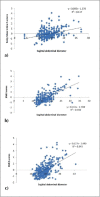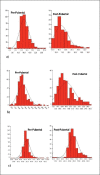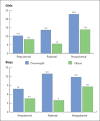Establishing abdominal height cut-offs and their association with conventional indices of obesity among Arab children and adolescents
- PMID: 20427937
- PMCID: PMC2886871
- DOI: 10.4103/0256-4947.62835
Establishing abdominal height cut-offs and their association with conventional indices of obesity among Arab children and adolescents
Abstract
Background and objectives: Obesity, particularly childhood obesity is common in the Middle East, but no studies have examined the relationship of sagittal abdominal diameter (SAD) or abdominal height to conventional markers of obesity in this region. This is the first study to document the association of SAD with measures of obesity among Arab children and adolescents.
Methods: Nine hundred sixty-four Saudi children aged 5-17 years (365 prepubertal, including 146 boys and 219 girls; 249 pubertal, including 125 boys and 124 girls; and 350 postpubertal, including 198 boys and 152 girls) were included in this cross-sectional study.
Results: SAD was significantly correlated with indices of obesity regardless of gender, but was strongest among pubertal boys. The cut-off values were as follows: for prepubertal children, 14 cm (equivalent to 50th percentile among girls and 60th percentile among boys); for pubertal children, 15 cm for girls (30th percentile) and 16 cm for boys (50th percentile), and for postpubertal, 21.5 cm for girls (70th percentile) and 22 cm for boys (80th percentile).
Conclusion: SAD is a reliable indicator of visceral obesity among Arab children and adolescents in particular. Prospective studies should be done to determine whether such an association translates to a promising risk factor for hard endpoints such as diabetes mellitus and coronary heart disease.
Figures



References
-
- Larsson I. Human body composition: Reference data and anthropometric equations, the metabolic syndrome and risk. Scand J Nutr. 2005;49:133–4.
-
- Vague J. The degree of masculine differentiation of obesities: A risk factor for determining predisposition to diabetes, atherosclerosis, gout, and uric calculous disease. Am J Clin Nutr. 1956;4:20–34. - PubMed
-
- Canoy D, Boekholdt SM, Wareham N, Luben R, Welch A, Bingham S, et al. Body fat distribution and risk of coronary heart disease in men and women in the European Prospective Investigation Into Cancer and Nutrition in Norfolk cohort: A population-based prospective study. Circulation. 2007;11:2933–43. - PubMed
-
- Rexrode KM, Buring JE, Manson JE. Abdominal and total adiposity and risk of coronary heart disease in men. Int J Obes Relat Metab Disord. 2001;25:1047–56. - PubMed
-
- Rexrode KM, Carey VJ, Hennekens CH, Walters EE, Colditz GA, Stampfer MJ, et al. Abdominal adiposity and coronary heart disease in women. JAMA. 1998;280:1843–8. - PubMed
Publication types
MeSH terms
Substances
LinkOut - more resources
Full Text Sources

